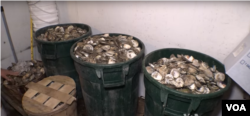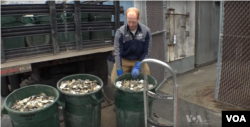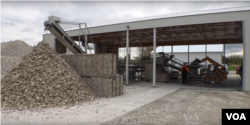Oysters are a favorite of seafood lovers across the United States. Oysters, a kind of shellfish, are native to U.S. waters on both the Atlantic and Pacific coasts.
Now, more than 20 eateries and other seafood businesses have joined together on a project to help the environment. Their goal is to collect old oyster shells and use them to grow new oysters. Project organizers say the recycled shells can also act as a filter. They remove dirty particles from the water.
Tony Price is with the Shell Recycling Alliance, a program of the Oyster Recovery Partnership. The program collects discarded oyster shells from seafood restaurants. It then uses the shells as homes for baby oysters.
Price told VOA that his truck stops at storage areas behind restaurants to collect containers filled with smelly shells.
"We do seven pickups a week, plus events on weekends,” he says. “I'd say we're getting somewhere between 500 and even 800 bushels a week."
Last year, the program collected 33,400 bushels of shells from restaurants around the Chesapeake Bay area. Every half shell collected becomes a new home for about 10 baby oysters.
A win-win
Oysters have been a popular choice at Mike's Crab House in Riva, Maryland, since 1958. Mike’s is one of more than 330 eateries in Maryland, Virginia and Washington D.C. that now recycle oyster shells.
Tony Piera says he and Mike's other owners joined the program four years ago.
"It's a win-win for us. It's a win-win for the environment. Now, the Oyster Recovery comes here two days a week, and they pick them up."
Over the past year, Mike's Crab House has donated a lot of shells to the program. It is one of the top 10 donors, with more than 822 bushels of recycled oyster shells in 2017.
Piera says he thinks more people come to his restaurant now because they know he recycles there.
"They know it's good for the environment, and the Chesapeake Bay."
Saving the bay with saved oysters
The Oyster Recovery Partnership began in 2010 with 22 restaurants. Karis King works for the partnership. She says the program has been well received and is growing.
"We've continued to grow and expand from us basically knocking on doors, trying to get people involved… It's turned into requests every single day, How do we become a part of this program?' I'm really excited about the program.' I want to do my part.'"
The program offers assistance to persuade more restaurants to join. In Maryland, restaurant owners can get tax credits based on how many bushels they donate. The group also educates the restaurant workers about the program and why recycling oyster shells is important.
New homes for new oysters
After the shells are collected, the next step is to take them to an area where they are cleaned. The shells sit in the open air for about a year so they can dry and have any living tissue die off and break down. Next, high pressure water is used to clean the shells. This gives them a nice white color.
Then, the shells go to the University of Maryland's Center for Environmental Science Horn Point Oyster Hatchery.
Stephanie Alexander leads the hatchery. She says her team gets small baby oysters, called spat, ready for their new homes.
"We get adult oysters, we spawn them and create the babies. And then, we grow those baby oysters for about two to three weeks. Then they mature and then we attach them to shells to become spat on shell."
After attaching the spat to the recycled oyster shells, they are returned to Chesapeake Bay. Here, they will continue to grow and increase the oyster population.
Alexander says new generations of oysters are very important for the health of the Chesapeake because they help clean the water. Cleaner water creates a healthier environment for fish, other seafood and plants.
The Shell Recycling Alliance is always looking for more restaurants to join. This is good for the coastal community, and for people who love to eat oysters.
I’m Phil Dierking.
Faiza Elmasry reported this story for VOANews.com. Phil Dierking adapted her report for Learning English. George Grow was the editor.
Do you recycle any animal shells in your country? Write to us in the Comments Section or on our Facebook page.
______________________________________________________________
Words in This Story
attach - v. to fasten or join one thing to another
mature - adj. having or showing the mental and emotional qualities of an adult
filter - v. to pass (something, such as a gas or liquid) through a filter to remove something unwanted
bushel - n. a unit for measuring an amount of fruit and grain that is equal to about 35.2 liters in the U.S. and to about 36.4 liters in the U.K.
bay - n. a large area of water that is part of an ocean or lake and partly surrounded by land
discard - v. to throw (something) away because it is useless or unwanted
pickup - v. collect something that has been left elsewhere.
knock - v. to hit something (such as a door) with the knuckles of your hand or with a hard object (such as a knocker) in order to get people's attention










